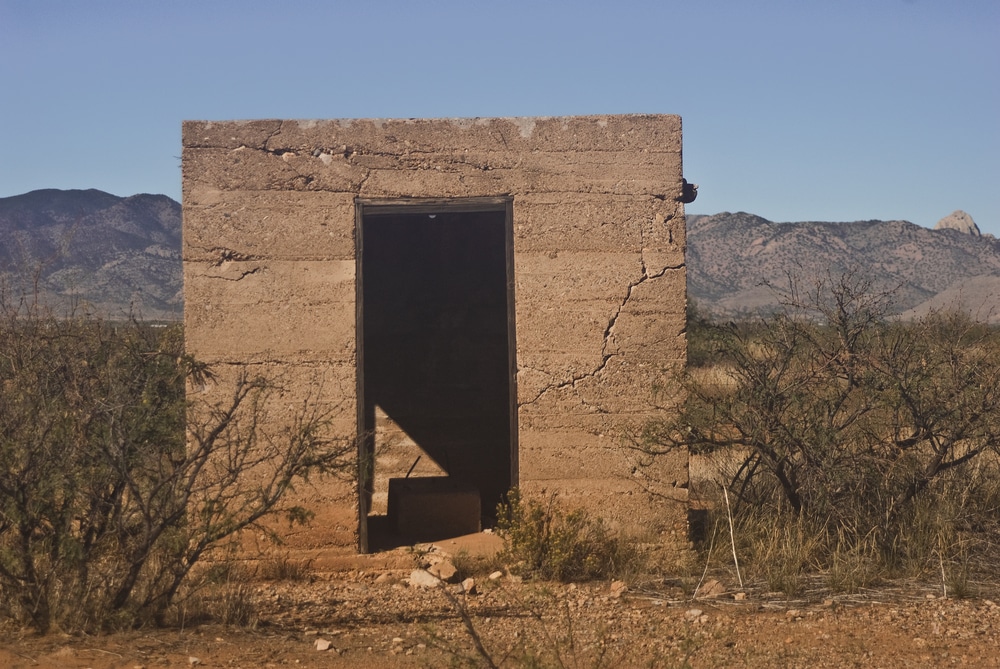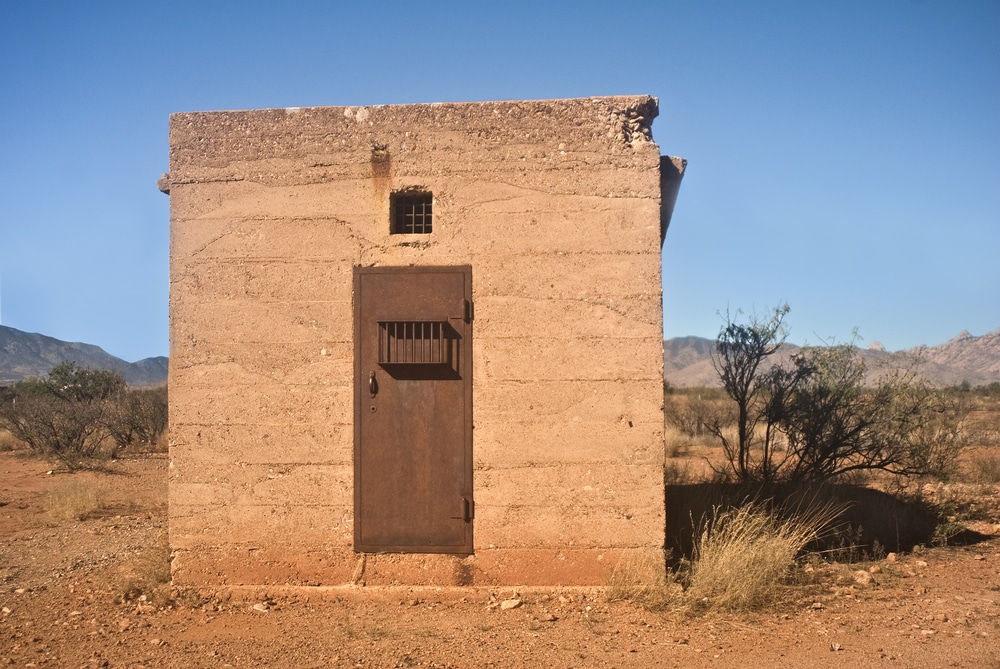The morning sun illuminates the stark beauty of Ajo’s landscape, casting long shadows across the open-pit mine that dominates the eastern edge of town. Unlike many of Arizona’s mining communities that flared briefly before fading into ghost towns, Ajo represents a different story—one of remarkable persistence through boom and bust cycles. Nestled in the Sonoran Desert of southwestern Arizona, approximately 43 miles from the Mexican border, this community still stands as a living testament to Arizona’s mining heritage, though much diminished from its heyday. The town’s Spanish name, meaning “garlic” (though some argue it derives from a Tohono O’odham word for paint), reflects the cultural crossroads where Anglo, Mexican, and Native American influences have converged for generations.

Pearce was founded around 1894 following the discovery of gold and silver at the Commonwealth Mine. Today, visitors can stroll through the historic district to see preserved and decaying buildings, including:
Old Pearce General Store
Blacksmith Shop
Pearce Post Office (still operational!)
This area offers a window into what life was like during the town’s boom.
Once one of Arizona’s richest gold mines, the Commonwealth Mine site contains visible remnants of mining structures, tailings, and rusted equipment. While you can’t enter any shafts, the surrounding area is accessible for hiking and exploration, with clear signs of the town’s mining heritage.
Pearce is a part of Arizona’s “Ghost Town Trail,” which includes nearby towns like Courtland and Gleeson. These sites offer additional ruins and interpretive signs, making for a fantastic day trip for history lovers and photographers.

The aptly named Ghost Town Road runs through Pearce and into neighboring ghost towns, providing beautiful views of the Sulphur Springs Valley. It’s especially scenic at sunrise or sunset when the surrounding mountains light up in desert hues.

Just a short drive from Pearce, Sunsites is a small but active retirement and ranching community. It offers a few local cafes, art galleries, and amenities, making it a good pitstop for lunch or supplies.

Located west of Pearce, Cochise Stronghold is a rugged, granite-filled canyon in the Coronado National Forest. It was the historic refuge of Apache Chief Cochise. Visitors can hike trails like:
Stronghold Nature Trail
Cochise Trail (leading to a panoramic overlook)
The area is known for birdwatching, picnicking, and incredible rock formations.

The surrounding Sulphur Springs Valley is a prime spot for birdwatching, especially during the winter migration season. Look for sandhill cranes, hawks, and owls. Several birding festivals and events are held nearby throughout the year.
Pearce’s remote location offers dark skies with little to no light pollution, making it an ideal location for stargazing. Bring a telescope or simply enjoy the Milky Way with the naked eye—perfect for photographers and astronomy enthusiasts.
The cemeteries, newspaper archives, and surviving structures of Pearce preserve remarkable human stories that illuminate life in this mining community. Among the most compelling is that of Sarah Pearce, wife of founder Jimmie Pearce, whose 1902 grave in the community cemetery features an elaborate marble angel. Historical accounts reveal that Sarah served as the community’s first nurse during its early years, using her ranching background and practical medical knowledge to assist with births, treat injuries, and comfort the dying. When typhoid swept through Pearce in 1901, she cared for numerous victims before contracting the disease herself. Her funeral, described in the Pearce Miner as “the largest yet seen in the settlement,” brought together all segments of the community in recognition of her service.
In the pioneer cemetery, the story of the Jiménez family unfolds across a row of small markers dating from 1906. Manuel Jiménez came to Pearce as a skilled carpenter from Sonora, Mexico, finding steady work building homes and business structures. According to newspaper accounts, when a fire destroyed several miners’ cabins, Jiménez organized fellow Mexican craftsmen to rebuild them at reduced cost. His success allowed him to bring his wife and children to Pearce, but tragedy struck when diphtheria claimed five of his seven children within two weeks. The community’s response transcended the ethnic divisions common in mining towns, with the Pearce Pioneer reporting that “men of all nations and stations” contributed to a fund supporting the grief-stricken family.
The Commonwealth Mine’s longest-serving superintendent, Edward Loosely, represents another significant figure in Pearce’s history. His substantial family plot in the community cemetery, marked by a granite obelisk, stands as a testament to his prominence. Cornish by birth, Loosely brought technical expertise developed in England’s tin mines to Pearce in 1897. Company records indicate he introduced several innovations in ore processing that increased silver recovery rates. Unlike many mining executives who maintained distance from workers, Loosely regularly descended into the mine to inspect operations personally. This practice likely contributed to his eventual death from “miner’s consumption” (silicosis) in 1918, demonstrating that even management positions carried health risks in mining communities.
Newspaper accounts preserve the remarkable story of Wing Lee, a Chinese merchant whose unexpected death in 1908 revealed the complex social dynamics of frontier mining towns. The Pearce Miner reported that Lee’s laundry business had served the community for over a decade, with the proprietor developing a reputation for extending credit to miners between paydays. Though subject to the discrimination common toward Chinese immigrants throughout the West, Lee had earned sufficient respect that local businesses closed during his funeral, and several leading citizens served as pallbearers—a noteworthy recognition in an era of significant anti-Asian sentiment.
Marriage records and cemetery plots reveal interesting patterns of community formation. The González-Miller family plot in the community cemetery tells the story of cross-cultural bonds formed in the crucible of frontier life. Maria González, daughter of a Mexican mine worker, married William Miller, an Anglo teamster, in 1904. Their union was noted in both newspapers, with the Pioneer specifically commenting on the “harmonious blending of cultures” at their wedding celebration. Their descendants maintained connections to Pearce for generations, with family members interred in the same plot as recently as 1978, long after mining operations ceased.
Personal journals preserved in the Arizona Historical Society collection provide intimate glimpses of daily life. The diary of schoolteacher Eleanor Simmons, who taught in Pearce from 1905 to 1911, describes the challenges of educating children in a transient mining community where attendance fluctuated with mining fortunes and seasonal agricultural work. Her accounts of community celebrations, particularly Fourth of July festivities that brought together “Mexicans and Americans, miners and merchants” for baseball games, music, and feasting, illustrate how shared experiences sometimes bridged the social divisions typical of mining communities.

| Category | Details |
|---|---|
| Name | Pearce, Arizona |
| Type | Semi-ghost town / Historic rural community |
| County | Cochise County |
| Founded | 1894 |
| Status | Partially inhabited; some historic structures preserved |
| Population (Historic) | Estimated 1,500+ at its peak around 1919 |
| Population (Current) | Small population; part of the Sunsites-Pearce census area (~2,100 total) |
| Historical Significance | Centered around the Commonwealth Mine, one of Arizona’s richest gold producers |
| Founder | James Pearce, who discovered gold while ranching in the area |
| Main Industry (Historic) | Gold and silver mining |
| Ore Value | Commonwealth Mine produced over $8 million in gold and silver |
| Decline Factors | Ore depletion, Great Depression, closure of mine in the 1940s |
| Notable Sites | Historic Pearce General Store, post office, schoolhouse, mine ruins |
| Preservation Status | Some structures restored or maintained; others in ruins |
| Nearby Attractions | Ghost towns of Courtland and Gleeson, Dragoon Mountains, Cochise Stronghold |
| Access | Located along State Route 191, southeast of Benson, AZ |
| Elevation | Approx. 4,400 feet (1,341 meters) |
| Climate | Mild winters, warm summers; high desert climate |
| Best For | Ghost town tourists, Old West history fans, photographers, nature lovers |
Pearce’s story begins with a fortuitous discovery in 1894 when a local rancher named Jimmie Pearce stumbled upon rich silver deposits while searching for stray cattle in the foothills of the Dragoon Mountains. Recognizing the potential wealth beneath his feet, Pearce established the Commonwealth Mine, which would become one of Arizona’s major silver producers. By 1896, a small community had sprung up around the mine, officially designated as Pearce in honor of its founder.
The economic foundation of Pearce rested primarily on silver mining, though gold, lead, and zinc were also extracted from the Commonwealth Mine and surrounding claims. The town’s development accelerated dramatically when the Commonwealth Mining and Milling Company invested heavily in infrastructure, constructing a modern processing mill that could handle 100 tons of ore daily.
Pearce’s growth coincided with a crucial period in Arizona’s development. Unlike earlier mining booms that occurred during the territorial period, Pearce emerged during Arizona’s push toward modernization and eventual statehood in 1912. This timing meant that Pearce’s development included amenities that earlier mining camps often lacked—planned streets, substantial commercial buildings, and modern utilities.
At its peak in 1919, Pearce boasted a population of approximately 1,500 residents. The community’s composition reflected the diverse nature of Arizona mining towns, with Anglo-American miners and business owners, Mexican laborers, European immigrants (particularly Cornish miners known for their expertise), and a small contingent of Chinese merchants who operated laundries and restaurants.
The town’s prosperity was reflected in its substantial infrastructure. Pearce boasted a school, multiple churches, a post office (established in 1896), several saloons, a hotel, and a variety of retail establishments. The Arizona Eastern Railroad connected Pearce to wider markets in 1903, enhancing the town’s economic viability and ending its isolation.
A significant moment in Pearce’s development came in 1904 when the Pearce General Store was constructed—a two-story adobe building that still stands as the town’s most prominent remaining structure. This mercantile establishment, later expanded to include a bank, became the commercial and social heart of the community.
The Commonwealth Mine, the economic engine of Pearce, produced over $15 million in silver and other minerals during its operation—equivalent to well over $200 million in today’s currency. This output established Pearce as one of Arizona’s significant mining operations, though it never achieved the fame of Tombstone or Bisbee.
Modern visitors to Pearce encounter a landscape where the past and present coexist in fascinating tension. Unlike many Arizona ghost towns located in remote mountain regions, Pearce is readily accessible via State Route 191, approximately 27 miles south of Willcox. This accessibility has resulted in both preservation opportunities and challenges.
The most prominent remaining structure is the Pearce General Store, an imposing two-story adobe building that anchored the town’s commercial district. Though weathered by time, the building retains much of its original character, with large storefront windows and the faded outline of painted advertisements still visible on its exterior walls. The store operated continuously until the 1970s, long after mining operations ceased, serving the small ranching community that persisted in the area.
Adjacent to the general store stands the Old Pearce Post Office, a small adobe structure that continued functioning until 1974. The building has been stabilized in recent years, with its distinctive wooden porch and hitching posts offering visitors a glimpse into daily life during Pearce’s heyday.
Further exploration reveals the concrete foundations of the Commonwealth Mine’s processing mill on the hillside above town. This sprawling industrial complex once housed crushing machinery, concentration tables, and cyanidation tanks used to extract precious metals from ore. Today, only concrete pads, partial walls, and scattered machinery components remain, slowly returning to the earth as nature reclaims the site.
The Pearce Cemetery, situated on a gentle slope approximately a half-mile east of the town center, provides perhaps the most poignant connection to the community’s past. Surrounded by a weathered iron fence, the cemetery contains approximately 300 graves, including both marked plots and numerous unmarked burials. The cemetery remains a place of quiet dignity, though subject to the harsh effects of desert winds, summer monsoons, and winter freezes.
Several residential structures survive in various states of preservation, ranging from nearly intact adobe homes to crumbling foundations overgrown with desert vegetation. These dwellings, mostly modest in size and construction, reflect the working-class nature of much of Pearce’s population.
Today’s Pearce exists as a rural community of approximately 1,200 residents, though most live in scattered ranches and modern homes outside the historic townsite. A small museum operated by the Pearce Preservation Association maintains limited hours, displaying artifacts, photographs, and documents related to the town’s mining heritage.
Unlike some ghost towns that have been repurposed as tourist attractions with guided tours and reconstructed buildings, Pearce retains an authentic, if somewhat neglected, character. Most buildings are privately owned, and visitors are asked to respect property boundaries while exploring the public areas of the historic district.
The Pearce Cemetery, established shortly after the town’s founding in the mid-1890s, offers a powerful testament to the lives, hardships, and diversity of this mining community. Located on elevated ground safely beyond the reach of seasonal flash floods, the cemetery’s position provides sweeping views of the Sulphur Springs Valley and the Dragoon Mountains beyond.
The cemetery contains approximately 300 marked graves, with local historians estimating at least 100 additional unmarked burials. The earliest dated marker belongs to Thomas McGuire, a 32-year-old miner killed in a shaft accident in 1895, mere months after mining operations began. His simple wooden cross, replaced by a more durable stone marker in the 1930s, represents the beginning of a continuous record of the community’s losses and remembrances.
The grave markers display remarkable diversity in materials, craftsmanship, and symbolism, reflecting the economic and cultural backgrounds of Pearce’s residents. Wealthy mine officials and business owners are commemorated with substantial marble monuments featuring elaborate carvings of religious figures, weeping willows, and clasped hands symbolizing farewell. Working-class miners and their families often have simpler markers, including locally produced wooden crosses, concrete tablets, and fieldstone arrangements.
Cultural and religious differences are evident throughout the cemetery. The eastern section contains several graves with distinctive Hispanic Catholic traditions, including colorful tile work, small niches for candles, and wrought iron crosses. A small area in the northwestern corner includes markers with Chinese characters, a rare surviving record of the Asian immigrants who operated businesses in Pearce but were often marginalized in life and death.
The inscriptions and dates on these markers reveal much about the challenges of frontier mining life. A sobering number of graves belong to children and infants, with multiple small markers bearing the same family names and death dates suggesting infectious disease outbreaks. Epitaphs mention mining accidents, “consumption” (tuberculosis, often associated with mining dust), and “desert fever” (likely typhoid or other waterborne illnesses), providing stark evidence of the hazards faced by residents.
The cemetery’s condition varies significantly across its expanse. Some family plots receive regular maintenance from descendants still living in southern Arizona, while others have succumbed to the elements, with wooden markers deteriorated beyond recognition and stone monuments toppled by time or vandalism. The Pearce Preservation Association conducts periodic clean-up events, focusing on brush removal, marker stabilization, and boundary maintenance to prevent further deterioration.
Beyond the original pioneer cemetery, Pearce established a separate community cemetery in the early 1900s as the town grew and became more organized. Located approximately a mile north of the original burial ground, this cemetery reflects the evolution of Pearce from mining camp to established community.
Unlike the somewhat haphazard layout of the pioneer cemetery, the community cemetery displays careful planning with formal rows, family plots, and designated sections. This organization reflects the increasing stability and prosperity of Pearce as it matured from frontier outpost to established town.
The approximately 250 graves in the community cemetery show clear evidence of changing burial customs and economic circumstances. Early 20th century markers transition from local craftsmanship to commercially produced monuments, often ordered from companies in Tucson or Phoenix and transported to Pearce via the railroad that connected the town to larger markets after 1903.
Family names repeated throughout the cemetery—Johnson, Rodríguez, Miller, González—tell the story of families who put down roots in Pearce, often transitioning from mining to ranching or commerce as the town’s economic base diversified. Multiple generations of these families rest side by side, providing a physical record of community continuity despite economic changes.
Cultural traditions remain evident in burial and commemorative practices. Hispanic graves often feature colorful ceramic decorations and the continuing tradition of Día de los Muertos celebrations, evident in the remains of candles, paper flowers, and offerings. Anglo graves typically display more restrained Protestant symbolism focusing on religious imagery, while some reflect Masonic or other fraternal organization membership through appropriate symbols.
The community cemetery includes several notable monuments to Pearce’s civic leaders. A substantial obelisk marks the grave of James Pearce himself, who died in 1921 after witnessing the community that bore his name rise to prominence and begin its gradual decline. The town’s longest-serving postmaster, Elizabeth Carmichael (1908-1932), is commemorated with a distinctive marble book, its pages eternally open to symbolize a life of service and communication.
While the pioneer cemetery ceased accepting new burials in the 1920s, the community cemetery continues to serve the area’s small population, with occasional interments of longtime residents and descendants of original settlers. This continued use has contributed to better maintenance and preservation of the community cemetery compared to its pioneer counterpart.
Pearce’s development coincided with the golden age of small-town journalism, and the community supported two newspapers during its heyday. The Pearce Miner, established in 1897, was the first to chronicle the town’s growth and activities. Founded by William E. Hattich, a printer who followed mining booms across the Southwest, the weekly publication combined local news, mining information, and national headlines reprinted from wire services.
The Miner established its printing office in a modest adobe building on Main Street, where a Washington hand press produced approximately 500 copies weekly. The newspaper maintained a generally conservative editorial stance, supporting mine owners’ interests and Republican political candidates while advocating for Arizona statehood and infrastructure development.
In 1903, a competing publication emerged—the Pearce Pioneer, founded by Samuel F. Ramsey, who had previously operated newspapers in Tombstone and Bisbee. The Pioneer positioned itself as “the voice of the working man,” with a progressive editorial stance more sympathetic to labor concerns and Democratic politics. This editorial rivalry reflected the broader political and economic tensions within mining communities throughout Arizona.
Both newspapers documented community milestones, from the construction of public buildings to mining developments, social events, births, deaths, and marriages. Surviving copies provide invaluable windows into daily life, revealing everything from the products available at the general store to attendance at school functions, church activities, and union meetings.
The newspapers played crucial roles during community crises. When typhoid threatened Pearce in 1905 due to contaminated water supplies, both publications provided public health information and called for improved sanitation. During labor disputes at the Commonwealth Mine in 1907, the papers offered contrasting perspectives, with the Miner supporting management positions while the Pioneer advocated for workers’ demands.
The influence of these publications extended beyond Pearce, as they were distributed to other settlements in Cochise County and exchanged with newspapers throughout Arizona Territory. This network facilitated information sharing and helped position Pearce within the broader regional community.
As mining activity declined in the 1920s, both newspapers struggled. The Pioneer ceased publication in 1923, while the Miner continued with reduced frequency and page count until finally closing in 1927. The printing equipment from the Miner was sold to a newspaper in Willcox, while the Pioneer’s press was reportedly transported to Mexico for use in a Sonoran mining town.
Today, scattered copies of both newspapers are preserved in the Arizona Historical Society archives in Tucson and the Arizona State Library in Phoenix. These yellowed pages provide some of the most direct connections to Pearce’s vibrant past, capturing the community’s voice through periods of prosperity and decline.
Pearce’s development was significantly enhanced by its railroad connections, which ended the isolation that hampered many Arizona mining communities. The Arizona Eastern Railroad completed a spur line to Pearce in 1903, connecting the town to the Southern Pacific main line at Cochise and thereby to regional and national transportation networks.
This railroad access transformed Pearce’s economy and development. Before the rail connection, ore had to be transported by wagon to distant processing facilities or shipping points, an expensive and time-consuming process that limited production. Similarly, supplies for the mine and community arrived via freight wagons on rough roads, increasing costs and restricting the availability of goods.
The railroad’s arrival brought immediate changes. A proper depot was constructed on the western edge of town, a single-story frame building with a ticket office, waiting room, and freight storage area. A water tower and coal storage facility were built nearby to service steam locomotives. These structures became important landmarks in Pearce, with the depot serving as both transportation hub and social gathering place.
The Commonwealth Mining and Milling Company was the primary beneficiary of rail service, using it to ship concentrated ore to smelters in Douglas and El Paso at significantly reduced cost. The company constructed a short narrow-gauge line from the mine to the mill and main rail depot, creating an efficient transportation system for moving ore and materials.
For Pearce residents, the railroad provided passenger service to Tucson, Bisbee, and points beyond, opening the isolated mining town to the wider world. The daily passenger train became an important community timekeeper, with many residents gathering at the depot regardless of whether they were traveling. Mail delivery became more reliable, and newspapers arrived promptly rather than days or weeks after publication.
Railroad employees formed an important segment of Pearce’s population. The station agent, telegrapher, section foreman, and track maintenance crews occupied company housing near the depot, creating a distinct neighborhood with its own social dynamics. Many of these railroad families remained in Pearce longer than mining personnel, providing continuity during economic transitions.
Freight service proved vital to Pearce’s commercial development. The Pearce General Store expanded its inventory dramatically after rail service began, offering furniture, machinery, and perishable goods previously unavailable or prohibitively expensive. Locomotives pulled cars loaded with lumber for construction, coal for the mine’s steam engines, and machinery too heavy for wagon transport.
As mining activity declined in the 1920s and 1930s, railroad service was gradually reduced. Passenger trains were the first casualty, replaced by a mixed train (combined passenger and freight) that served Pearce three times weekly. By 1941, regular service had been discontinued entirely, though occasional freight runs continued on an as-needed basis until the tracks were finally removed in 1961.
Today, the former railroad right-of-way remains visible as a raised grade cutting through the landscape, with scattered telegraph poles marking its path. The depot building was dismantled in the 1950s, though its concrete foundation remains, partially obscured by desert vegetation. These remnants represent an important chapter in Pearce’s connectivity to the wider world and the crucial role transportation played in the town’s development and eventual decline.
Pearce’s decline began gradually in the early 1920s as the Commonwealth Mine’s profitable ore bodies became increasingly difficult and expensive to access. Unlike some mining operations that closed suddenly when veins were exhausted, Pearce experienced a phased contraction as the mining company reduced operations incrementally while exploring for new deposits.
The global economic factors of the post-World War I period accelerated this decline. Silver prices fell dramatically from their wartime highs, reducing the profitability of even productive sections of the mine. By 1922, the Commonwealth Mining and Milling Company had reduced its workforce by more than half, operating with skeleton crews and focusing on the most accessible remaining ore.
In 1927, regular mining operations ceased entirely. The company maintained a small maintenance staff to prevent flooding and collapse of the main shafts, holding out hope for eventual resumption if metal prices improved. This hope briefly materialized during a short-lived revival in the mid-1930s when the Great Depression drove precious metal prices higher and made marginal operations temporarily viable. This period brought a small influx of population, but never restored Pearce to its former vitality.
The final closure came in 1940 when the company determined that remaining ore reserves could not be profitably extracted with existing technology. Equipment was sold or salvaged, shafts were sealed for safety, and the mining era of Pearce officially ended.
Unlike the rapid abandonment seen in some mining towns, Pearce’s population declined gradually. The 1930 census recorded approximately 500 residents, down significantly from the peak but still representing a viable community. Some residents transitioned to ranching and agriculture in the surrounding Sulphur Springs Valley, while others found employment with the railroad or in nearby towns like Willcox and Douglas.
The town’s commercial district contracted as businesses closed or relocated. The Pearce Pioneer newspaper ceased publication in 1923, while the Miner continued with reduced frequency until 1927. The bank inside the general store closed following the stock market crash of 1929, though the mercantile portion continued operating. The post office remained functional until 1974, serving a dwindling population and surrounding ranch families.
School enrollment declined steadily, with the impressive two-story schoolhouse (constructed during the boom years) operating with a single teacher and multiple grade levels by the 1940s. When student numbers fell below viable levels in 1956, the school district was consolidated with neighboring Sunsites, and the building was closed.
Both cemeteries continued to receive occasional burials even as the town declined. The pioneer cemetery saw its last interments in the 1930s, while the community cemetery continued to accept burials from local ranching families and former residents who wished to be buried among their ancestors. Today, new burials in the community cemetery are rare but not unknown, particularly for descendants of historic Pearce families who maintain connections to the area.
The final stage of transition came in the 1970s as Pearce evolved from dying mining town to rural residential area and historic site. The completion of Highway 191 improved access to the region, and the development of the retirement community of Sunsites nearby brought new residents attracted by the climate and affordable land. While not restoring the town to its former activity level, this transition prevented Pearce from becoming completely abandoned, unlike many mining towns throughout Arizona.
Pearce holds an important place in Arizona’s mining heritage, representing the silver mining operations that helped drive economic development during the territory’s transition to statehood. While not as famous as Tombstone or Jerome, Pearce’s Commonwealth Mine was actually one of Arizona’s most productive silver producers, contributing significantly to the state’s mineral output during the early 20th century.
The town has been recognized for its historical significance through inclusion in the Arizona State Historic Preservation Office’s inventory of important mining settlements. The Pearce General Store and Post Office were added to the National Register of Historic Places in 1978, acknowledging their architectural significance and role in community life.
Archaeological surveys have documented the townsite and mining operations, most recently a 2012 University of Arizona study that mapped remaining structures and established a more complete understanding of the settlement’s industrial processes and community layout. These studies have enhanced understanding of how mining technology evolved during Pearce’s operational period and how the community adapted to changing economic circumstances.
Pearce holds cultural significance to multiple communities. For Hispanic families throughout Cochise County, the town represents an important early Mexican-American settlement where Hispanic pioneers established businesses, worked the mines, and contributed to Arizona’s development. Descendants of these families often visit the cemetery on traditional observances such as Día de los Muertos.
Today, Pearce plays a modest role in regional tourism, primarily attracting history enthusiasts and photographers interested in ghost towns and mining heritage. The Pearce Preservation Association, founded in 1986, maintains a small museum in a repurposed company building, displaying artifacts, photographs, and documents related to the town’s mining era. This volunteer organization hosts periodic events highlighting Pearce’s history and coordinates with regional tourism initiatives to promote responsible visitation.
Educational groups from Tucson and surrounding communities occasionally use Pearce as a field site for studying Arizona history, industrial archaeology, and environmental reclamation. The visible transition from mining operations to current conditions provides tangible examples of human impact on the landscape and natural recovery processes.
The pioneer and community cemeteries of Pearce face different preservation challenges. The pioneer cemetery, being older and less regularly visited, has suffered more from neglect and environmental damage. Desert flash floods have eroded portions of the cemetery grounds, displacing some markers and exposing others. Unrestricted access has unfortunately led to occasional vandalism and theft of historical artifacts.
The community cemetery has fared somewhat better, benefiting from continued use and maintenance by descendants still living in the area. Since 1995, a volunteer group called the Friends of Pearce Cemeteries has conducted semi-annual clean-up efforts, focusing on brush removal, marker stabilization, and boundary maintenance to prevent further deterioration.
In 2008, the Arizona Pioneer & Cemetery Research Project conducted documentation of both cemeteries, photographing remaining markers and recording inscriptions. This information is now housed in the Arizona State Library’s Genealogy Collection, providing a valuable resource for researchers and descendants seeking to connect with their Pearce roots.
Memorial practices continue on a limited scale. Each May, a small gathering of descendants and history enthusiasts commemorates Memorial Day at both cemeteries, placing flowers and conducting brief ceremonies to honor those buried there. This tradition, documented in historical records back to the early 1900s, maintains a thread of continuity despite the town’s physical decline.
Hispanic families with connections to Pearce often observe Día de los Muertos traditions at the cemeteries, cleaning graves, leaving offerings, and sometimes holding small family gatherings to honor their ancestors. These cultural practices ensure that certain sections of both cemeteries receive regular attention and maintenance beyond organized preservation efforts.
Recent years have seen growing interest in cemetery preservation as an aspect of heritage tourism. The Pearce Preservation Association has developed self-guided tour materials for the cemeteries, highlighting notable graves and explaining the symbolism found on markers. These materials emphasize respectful visitation practices and the historical significance of these burial grounds.
Conservation challenges remain significant. The harsh desert environment—intense sun, freeze-thaw cycles, occasional flooding—continues to damage markers and landscape features. Limited funding hampers more extensive preservation efforts, though grant applications to various historic preservation organizations have occasionally funded specific projects, such as the 2015 restoration of the cemetery entrance gates.
Visitors to Pearce and its cemeteries should approach these sites with respect for both their historical significance and their status as sacred spaces. The main historic district, centered around the Pearce General Store and Post Office, is easily accessible from Highway 191. While these structures are on private property, they are visible from public roads, and the owners occasionally permit visitors to examine the exteriors more closely if approached politely.
The cemeteries require more careful navigation. The community cemetery, located north of town on a well-maintained dirt road, remains active though infrequently used. Visitors should park in designated areas, close gates, and refrain from walking directly on graves, many of which may be unmarked or minimally identified.
The pioneer cemetery presents greater challenges, as access requires traversing private property on unmarked roads. Visitors are advised to inquire at the Pearce Preservation Association museum (open weekends) for current access information and to obtain permission if needed.
Ethical considerations for all historical sites in Pearce include refraining from any collection of artifacts. Even seemingly insignificant items like glass fragments, pottery shards, or metal objects contribute to the historical record and should remain in place. Photography for personal use is acceptable, though rubbing of headstones is discouraged as many are fragile and continued friction can accelerate deterioration.
The cemeteries face ongoing preservation challenges from environmental factors, vegetation growth, and occasional vandalism. Visitors can contribute to conservation by reporting damage to the Pearce Preservation Association and participating in organized clean-up events held each spring and fall.
The museum operated by the Pearce Preservation Association offers maps, historical photographs, and background information that enhances understanding of the sites. Volunteer docents, many descended from original Pearce families, provide valuable context and personal connections to the community’s history.
Pearce, Arizona stands as a poignant reminder of the boom-and-bust cycle that characterized so much of Arizona’s mining development. Its weathered buildings and silent cemeteries speak to the temporary nature of economic prosperity tied to resource extraction and the permanent mark such activities nevertheless leave upon the landscape and historical record.
The pioneer and community cemeteries tell a story not just of death but of life, adaptation, and the evolution from frontier outpost to established community and ultimately to near-abandonment. They remind us that even places considered “ghost towns” never truly die as long as their stories are remembered and connections maintained through descendants and historical interest.
As Arizona continues its rapid urbanization, places like Pearce offer increasingly valuable connections to the state’s formative period. Every weathered headstone and crumbling adobe wall preserves a piece of the complex history that shaped modern Arizona—a history of cultural exchange, economic ambition, and adaptation to one of North America’s most challenging environments.
For those willing to look beyond the obvious and listen to the quiet tales these places tell, Pearce offers insights into the lives of those who ventured to Arizona’s southeastern valleys, establishing a community at the base of the Dragoon Mountains. Their stories—of miners and merchants, railroad workers and ranchers, families and individuals—remind us of the diverse foundations upon which Arizona was built and the fleeting nature of prosperity when tied to finite resources.
Yet the persistence of some structures, the continuing use of the community cemetery, and the efforts of preservation organizations suggest that Pearce has achieved a form of permanence beyond its mining origins. The town has transitioned from boomtown to ghost town to historic site, each incarnation preserving elements of the past while adapting to changing circumstances—much like the pioneers who once called this place home.
Pearce is located in southeastern Arizona, accessible via State Route 191 approximately 27 miles south of Willcox and 30 miles north of Douglas. The historic townsite is clearly visible from the highway. The community cemetery can be reached via Cemetery Road, 1 mile north of the general store. The pioneer cemetery requires local guidance and appropriate permissions.